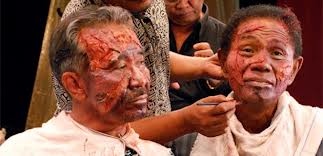
Man’s inhumanity to man. The banality of evil. One death is a tragedy; one million is a statistic. When it comes to systematic mass murder, human beings are adept at offering aphorisms, catch-phrases, and even a bon mot or two, but rarely anything by way of real explanation. After all, what on earth would suffice? There’s always backstory, context, and the seemingly unavoidable march of history, but once the bodies are counted, does any of it really make a difference? The dead stay dead, the perpetrators tagged and appropriately maligned, and future generations, well, we’re left where we began, constructing additional word puzzles to make us appear ever closer to the truth. We wrestle with our very nature, understanding that while such savagery is always a matter of time and place, there’s something essential to the very idea. Men kill, other men stand in stupefied shock, and the process repeats itself again and again. In the telling, one can almost see the shoulders shrug with helpless defeat.
Despite the general confusion, however, identifying and forever demonizing those responsible do appear to be the lone areas of consensus amongst the global community. From Israel’s never-ending journey to arrest, try, and execute every last member of the Nazi apparatus, up to and including janitors, cooks, and Reichstag plumbers, to America’s own self-flagellation regarding slavery and native purge, the world has reached a point where it appears inconceivable that evil, overtly expressed, could ever hope to receive the succor of silence. The guilty, it is said, will be found and held accountable. Unless they aren’t. Joshua Oppenheimer’s stunning documentary, The Act of Killing, sheds light on a nation that not only failed to root out and destroy the enemy within, but, to this day, refuses to even classify them as such. Shockingly (or not, depending on where you stand on the issue of historical amnesia), there were no riots, no uprisings, no outraged editorials, and certainly no trials. The brutality may as well have taken place on the moon.

From 1965-66, following the standard coup, Indonesian paramilitary groups (led by the Pancasila Youth), brutally murdered as many as one million suspected Communists, often with the tacit endorsement of other so-called enlightened nations. It was, as Time magazine said at the time, The West’s best news for Asia in years. As the victims were officially reclassified as anything but, American eyes and ears stayed shut good and tight, and without its own Sydney Schanberg to generate righteous indignation, the cause of bloodshed faded from view with nary a peep of protest.
Cold War indifference aside, however, The Act of Killing is not, at least on its face, a preachy polemic against comfortably clueless Yankees. Nor is it a fly on the wall re-examination of Indonesian politics in light of current troubles. Both have their place, but familiarity would have rendered them mere curiosities; worthwhile additions to the conversation, but hardly essential viewing. In fact, this is that rare documentary that seeks not to uncover the truth at all, but rather, refreshingly, why we lie. Evasion as survival, the very essence of our humanity.
But rather than plop the aging assassins on hard chairs before harsh lights, shouting unanswerable questions until guilt poured from sweaty facades, the filmmakers use the cinema itself to stir the soul. We’ll make a movie! And why not, given the preoccupation these self-described gangsters had with Hollywood heroes. Two such men, making their way as movie ticket scalpers before the uprising, soon graduated to instruments of torture and death once the government fell into more sinister hands. Throughout The Act of Killing, they reminisce about favorite actors, movies, and scenes, almost as if they are recalling first dates and childhood birthdays. But unlike other lads who took those images as inspiration for artistic careers or romantic endeavors, these boys found newer and better ways to kill. Most effective (and common, apparently) was the garroting-via-wire technique, both because it cut down on the volume of blood and ensured a victims’ inability to fight back. The Corleone family would approve.
Fond memories aside, our killers now walk the streets hunting not for fresh victims, but bit players in their diorama of death; the sons and daughters of the murdered to help fashion a fantasy not of revisionism, but instant replay. Citizens are both queried and seduced, recruited as if for Indonesia’s revival of Gone With the Wind; a production so spectacular that the nation will wonder how it ever lived without it. All they ask for is an attention to detail (should I dye my hair?), a fanaticism for that much-needed, and hyper-realistic, approximation of the past. Sure, it’s akin to finding a decidedly undead army of SS soldiers, sending them to Poland, and asking them to scour the area for Jews willing to help them make a movie about Auschwitz, but why bother with such trivia? These men want to put on a show, dammit, and who’s to say we can’t have a few laughs along the way? It is to the documentary’s credit, and our collective horror, that these men aren’t the least bit troubled by the task at hand, and like good little soldiers then and now, they put their hearts and souls into their work.
Viewers accustomed to humorless slogs through archival footage and Itzhak Perlman scores might object to any degree of levity regarding history’s holocausts, but what better way to demonstrate the utter futility of trying to fully understand? Hitler hated Jews, Turks hated Armenians, the Japanese hated the Chinese residents of Nanking, and, shockingly, the newly minted military dictatorship of Indonesia hated Communists. Where there’s a perceived threat, there will be a violent response. Whenever we put history’s villains on the couch, it’s rarely more insightful than that.
Add youth, mindless idealism, liquor, and an environment free from real-world consequences (say, your average Libertarian think tank), and the next task at hand will be mass burials. Large groups of men armed to the teeth rarely hold ice cream socials, so rather than bore us to tears with yet another lecture, The Act of Killing revolutionizes the medium with utter absurdity. Our subjects are, to a man, petri dishes of remorseless sociopathy, so if they’d prefer to stage a number before a striking waterfall, set to the tune of “Born Free,” who are we to judge? Meta-cinema, after all, isn’t the Hague.

So why would they do it? Why would history’s monsters reenact their crimes before a camera? The easy answer, of course, is that, with time, they’ve forgotten their acts and wish to re-live an unconscionable pleasure. Having not slit any throats for forty years, they’d like to give it another try, only this time from the comfort of storytelling. I suspect it’s more than that. Those long-ago murders, even at the time, were never all that real to begin with, and to stage them again decades later is no different than old band members getting together for a reunion concert. It was a job, a task to be performed, and we can’t understand it because we’ve never plumbed those depths.
If we chuckle at the dress-up that mocks the unfathomable lives lost, it is, as the saying goes, so we don’t cry. Sickness and depravity we’ve seen, but rarely to this degree. It’s made even more difficult to understand by the pride Indonesia continues to take in their acts. On occasion, an outlet or two has romanticized the outlaw or the American bad boy, but never anyone so accomplished in dispensing misery. Maybe the Duke’s The Green Berets.
Against the odds, there are some gorgeously framed shots in The Act of Killing, with the film about a film taking on an unexpected beauty amidst chaos. Is that allowed? Can we marvel at the technique for so revolting a cause? And maybe that’s the bookend to our tale. The cinema grants us so much by way of liberation, doesn’t it? We can live other lives, reinvent, reimagine, and right all wrongs in the time it takes for a reel or two to unspool before us. More than any other medium, the movies can challenge perceptions, reinforce prejudices, and craft narratives never before imagined.
All the great propagandists have understood its power, and most of all, they’ve deferred to its unyielding strength to clarify. Rationalize, if we’re being honest. History hasn’t bothered to remember the Indonesian slaughterhouse of the mid-1960s, but if it chooses to at a later date so these men think they’ll look to the film about the events, rather than the events themselves. It’s why any of us creates, in the end, be it author, director, painter, or madman. What we create, it is believed, will come to substitute for what inspired the creation. A new truth, fashioned from the oldest of lies.

Leave a Reply